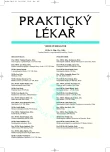Analysis of the lifestyle of seniors living at home focused on dietary habits
Analýza životního stylu seniorů žijících v domácím prostředí se zaměřením na stravovací návyky
Východisko:
Studie ukazují, že i snížení rizikových faktorů až ve stáří poskytuje ještě zdravotní výhody. Populace seniorů je heterogenní, a zatímco některé studie popisují neadekvátní stravování, jiné hodnotí stravování seniorů žijících doma celkem kladně. Cílem této studie bylo vyhodnocení stravovacích návyků a životního stylu soběstačných seniorů žijících v domácím prostředí.
Metody a výsledky:
S použitím dotazníku jsme v průběhu interview zaznamenali a poté vyhodnotili stravovací návyky a životní styl 103 náhodně vybraných osob, 39 mužů a 64 žen, ve věku 65–91 let žijících v Praze (54) a v menších městech (49). Kriterii výběru splněnými oslovením na veřejném prostranství byl život mimo instituci a určitá soběstačnost respondentů. Při porovnávání skupin respondentů bylo za statisticky významný rozdíl považováno p<0,05. Celkem 57 % respondentů mělo BMI 25 nebo více. Týdenní frekvence konzumace zeleniny a ovoce byla 12,8, mléka a mléčných výrobků 10,1, tmavého chleba a pečiva 6,2, masa 4,6 a bílého pečiva 4,6. Denní příjem tekutin třetiny respondentů byl nižší než doporučované minimum 2 litry. 40 (38,8 %) osob užívalo vitaminové a/nebo minerálové doplňky. Padesát sedm respondentů vykonávalo nějakou pohybovou aktivitu alespoň 3 krát týdně.
Stravovací návyky byly lepší u žen, u osob přesvědčených, že žijí zdravě a u nekuřáků (81 respondentů). Zvyky, nedostatek peněz, zdravotní obtíže a neznalost byly vnímány jako překážka zdravějšího stravování. Příčinou, v převažující většině kladných, změn ve stravování v minulosti bylo, až na výjimky, zjištěné onemocnění.
Závěry:
Výskyt nadměrné hmotnosti u seniorů je srovnatelný s jejím výskytem v České populaci. Stravování seniorů není horší než stravování populace a stejně jako u celé populace alarmujícím problémem je závažný nedostatek pohybu. Zjištění, že motivací ke změně stravování bylo až onemocnění a nikoliv jeho prevence naznačuje, že je potřebné hledat vhodný přístup jak populaci účinně motivovat ke změně životního stylu.
Klíčová slova:
stravovací návyky, výživa, životní styl, senioři.
Authors:
E. Kudlová; A. Slámová
Authors‘ workplace:
Přednosta: prof. MUDr. Vladimír Bencko, DrSc.
; Ústav hygieny a epidemiologie 1. LF UK v Praze
Published in:
Prakt. Lék. 2006; 86(8): 439-442
Category:
Reviews
Overview
Background:
Studies demonstrate that reducing lifestyle risk factors even in older age presents health advantages. The elderly population is heterogeneous and while some studies describe inadequate diet, others evaluate the diet of seniors living at home as reasonably good. The aim of the present study is to evaluate the dietary habits and lifestyle of self-sufficient seniors living at home.
Methods and results:
Using a questionnaire we recorded and subsequently evaluated the dietary habits and lifestyles of 103 randomly selected individuals, 39 males and 64 females, aged 65–91 years living in Prague (54) and in smaller cities (49). Selection criteria met by addressing the subjects through the normal public channels was living outside an institution and a certain level of self-sufficiency. A level of P < 0.05 was regarded as statistically significant when comparing groups of respondents. Fifty seven percent of respondents had BMI 25 or higher. The weekly frequency of fruit and vegetable consumption was 12.8, milk and dairy products 10.1, dark bread and pastries 6.2, meat 4.6 and white bread and pastries 4.6. The daily fluid intake of a third of respondents was lower than the recommended minimum of 2 litres. Forty (38.8 %) persons took vitamin and/or mineral supplements. Fifty seven respondents performed some physical activity at least 3 times a week. The dietary habits of women, of respondents convinced that they live healthily and of non-smokers (81 respondents) were better. Habits, lack of money, health problems and ignorance were perceived as obstacles to a healthier diet. With few exceptions, a diagnosed disease has been the motivation for past, mostly positive changes.
Conclusions:
The overweight prevalence in seniors is comparable to its prevalence in the general Czech population. The diet of seniors is not worse than that of population at large, and the lack of physical activity is an equally alarming issue as it is in the whole population. Finding that the incentive for change of diet was an illness and not its prevention suggests that it is necessary to seek suitable approaches how to motivate the population towards lifestyle change.
Key words:
dietary habits, nutrition, lifestyle, seniors.
Labels
General practitioner for children and adolescents General practitioner for adultsArticle was published in
General Practitioner

2006 Issue 8
- Metamizole vs. Tramadol in Postoperative Analgesia
- Memantine in Dementia Therapy – Current Findings and Possible Future Applications
- Memantine Eases Daily Life for Patients and Caregivers
- Metamizole at a Glance and in Practice – Effective Non-Opioid Analgesic for All Ages
- Spasmolytic Effect of Metamizole
Most read in this issue
- Contraception and surgery
- Anaerobic sepsis: Lemierre syndrome
- Stroke and myocardial infarction – parallels and paradoxes
- Tuberculosis at the present
